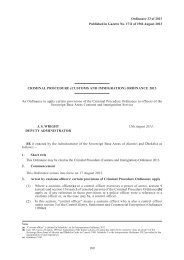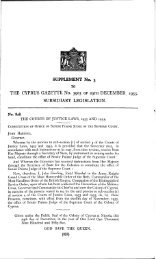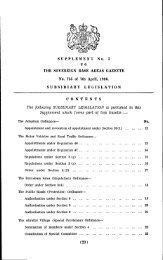Hydrological Study - Sovereign Base Areas Cyprus
Hydrological Study - Sovereign Base Areas Cyprus
Hydrological Study - Sovereign Base Areas Cyprus
Create successful ePaper yourself
Turn your PDF publications into a flip-book with our unique Google optimized e-Paper software.
Consulting CYPRUS<br />
Greater Sandplover, and breeding Black-winged Stilt, Eleonora’s and Peregrine<br />
Falcons and Griffon Vulture, it is also possible to estimate population sizes.<br />
On the other hand, data on population sizes of other important species, such as<br />
breeding, wintering and migrating populations of Mediterranean Shag, <strong>Cyprus</strong><br />
Warbler and Eurasian Thick-knee are not sufficient.<br />
Overall, the majority of data from the area has focused on the presence / absence of<br />
bird species in the area, and on calculating population sizes. Information on bird use<br />
around the antennas has also been studied. However, ecological studies of the<br />
requirements of particular species, e.g. of their breeding and feeding biology, or of<br />
food-web structures in the area, are lacking, apart from one study investigating the<br />
bird-habitat relationship of the bird species occurring at Akrotiri Peninsula. In this<br />
study, thirteen habitat types representing all habitat types found in the area, were<br />
identified and mapped, and monitored regularly for one year. One hundred and<br />
fifteen bird species were recorded throughout the duration of the study (Hadjikyriakou<br />
2011).<br />
4.4 Phallocryptus (Branchinella) spinosa<br />
4.4.1 Status of the taxonomy of Phallocryptus (Branchinella) spinosa<br />
The anostracan family of crustaceans known as Thamnocephalidae, particularly the<br />
genus Branchinella, has long been a convenient drawer to keep fairy shrimps with<br />
dubious affinities. It is only recently that Rogers (2003, 2006) made a major revision<br />
of the Branchinella genus and changed to Phallocryptus. We collected live<br />
specimens and shipped them to C. Rogers (world specialist in anostracan taxonomy)<br />
for positive ID.<br />
4.4.2 Status of Phallocryptus (Branchinella) spinosa in the IUCN Red List<br />
P. spinosa appear to be broadly distributed and without immediate threats to their<br />
continued existence, and it is categorized under the IUCN criteria as “Species of<br />
Least Concern” (Rogers 2006, and http://www.iucnredlist.org/apps/redlist/search).<br />
4.4.3 Status of Phallocryptus (Branchinella) spinosa in <strong>Cyprus</strong> and elsewhere<br />
The general distribution of Phallocryptus spinosa is a disjunct mosaic of populations:<br />
west to the Iberian Peninsula, through the Mediterranean Basin, Ukraine,<br />
48













